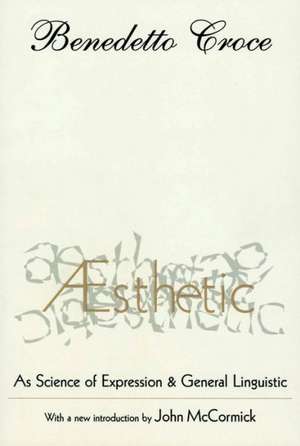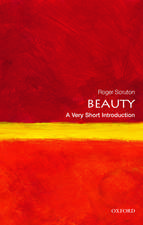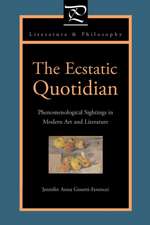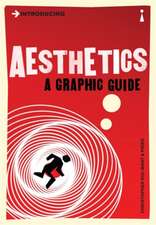Aesthetic: As Science of Expression and General Linguistic
Editat de Benedetto Croceen Limba Engleză Paperback – 15 apr 1994
Croce regards aesthetics not merely as a branch of philosophy, but as a fundamental human activity. It is inseparable from historical, psychological, political, economic, and moral considerations, no less than a unique frame of artistic reference. Aesthetic is composed of two parts: Part One concentrates on aesthetic theory and practice. Among the topics it covers are: intuition and expression, art and philosophy, historicism and intellectualism, and beauty in nature and in art. Part Two is devoted to the history of aesthetics. Croce analyzes such subjects as: aesthetic ideas in the Middle Ages and Renaissance, Giambattista Vico as the inventor of aesthetic science, the philosophy of language, and aesthetic psychologism.
In his new introduction to a classic translation, John McCormick assesses Croce's influence in aesthetic theory and historiography. He notes that the republication of this work is an overdue appreciation of a singular effort to resolve the classic questions of the philosophy of art, art for its own sake and art as a social enterprise; both find a place in Croce's system.
Preț: 446.75 lei
Nou
Puncte Express: 670
Preț estimativ în valută:
85.48€ • 89.49$ • 70.73£
85.48€ • 89.49$ • 70.73£
Carte tipărită la comandă
Livrare economică 05-19 aprilie
Preluare comenzi: 021 569.72.76
Specificații
ISBN-13: 9781560008187
ISBN-10: 1560008180
Pagini: 502
Dimensiuni: 152 x 229 x 28 mm
Greutate: 0.7 kg
Ediția:1
Editura: Taylor & Francis
Colecția Routledge
Locul publicării:Oxford, United Kingdom
ISBN-10: 1560008180
Pagini: 502
Dimensiuni: 152 x 229 x 28 mm
Greutate: 0.7 kg
Ediția:1
Editura: Taylor & Francis
Colecția Routledge
Locul publicării:Oxford, United Kingdom
Cuprins
I: Theory of Æsthetic; I: Intuition and Expression; II: Intuition and Art; III: Art and Philosophy; IV: Historicism and Intellectualism in Æsthetic; V: Analogous Errors in the Theory of History and in Logic; VI: The Theoretic Activity and the Practical Activity; VII: Analogy Between the Theoretic and the Practical; VIII: Exclusion of Other Spiritual Forms; IX: Indivisibility of Expression Into Modes or Degrees and Criticism of Rhetoric; X: Æsthetic Feelings and the Distinction Between the Beautiful and the Ugly; XI: Criticism of Æsthetic Hedonism; XII: The Æsthetic of the Sympathetic and Pseudo-Æsthetic Concepts; XIII: The “Physically Beautiful” in Nature and in Art; XIV: Errors Arising from the Confusion Between Physics and Æsthetic; XV: The Activity of Externalization. Technique and the Theory of the Arts; XVI: Taste and the Reproduction of Art; XVII: The History of Literature and Art; XVIII: Conclusion: Identity of Linguistic and Æsthetic; II: History of Æsthetic; I: Æsthetic Ideas in GræCo-Roman Antiquity; II: Æesthetic Ideas in the Middle Ages and Renaissance; III: Ferments of Thought in the Seventeenth Century; IV: Æesthetic Ideas in the Cartesian and Leibnitian Schools, And the “Æsthetic” of Baumgarten; V: Giambattista Vico; VI: Minor Æsthetic Doctrines of the Eighteenth Century; VII: Other Æsthetic Doctrines of the Same Period; VIII: Immanuel Kant; IX: The Æsthetic of Idealism: Schiller, Schelling, Solger, Hegel; X: Schopenhauer and Herbart; XI: Friedrich Schleiermacher; XII: The Philosophy of Language: Humboldt and Steinthal; XIII: Minor German Æstheticians; XIV: Æsthetic in France, England and Italy During the First Half of the Nineteenth Century; XV: Francesco De Sanctis; XVI: Æsthetic of the Epigoni; XVII: Æsthetic Positivism and Naturalism; XVIII: Æsthetic Psychologism and Other Recent Tendencies; XIX: Historical Sketches of Some Particular Doctrines; I: Rhetoric: Or the Theory of Ornate Form; II: History of the Artistic and Literary Kinds; III: The Theory of the Limits of the Arts; IV: Other Particular Doctrines; Bibliographical Appendix
Descriere
Benedetto Croce is one of the most influential philosophers of the twentieth century. His work in aesthetics and historiography has been controversial, but enduring. When the first edition of ^Esthetic appeared in 1902, Croce was seen as foremost in reasserting an idealistic philosophy, which despite its source in continental idealists from Descartes to Hegel, offers a system that attempts to account for the emergence of scientific systems. Croce thus combines scientific and metaphysical thought into a dynamic aesthetic.Croce regards aesthetics not merely as a branch of philosophy, but as a fundamental human activity. It is inseparable from historical, psychological, political, economic, and moral considerations, no less than a unique frame of artistic reference. Aesthetic is composed of two parts: Part One concentrates on aesthetic theory and practice. Among the topics it covers are: intuition and expression, art and philosophy, historicism and intellectualism, and beauty in nature and in art. Part Two is devoted to the history of aesthetics. Croce analyzes such subjects as: aesthetic ideas in the Middle Ages and Renaissance, Giambattista Vico as the inventor of aesthetic science, the philosophy of language, and aesthetic psychologism.In his new introduction to a classic translation, John McCormick assesses Croce's influence in aesthetic theory and historiography. He notes that the republication of this work is an overdue appreciation of a singular effort to resolve the classic questions of the philosophy of art, art for its own sake and art as a social enterprise; both find a place in Croce's system.















